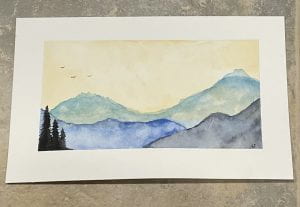In-Depth #2

During my last meeting with my mentor, Jason, we talked about how he got introduced to watercolor painting as well as supplies that have worked for him. We discussed what watercolors mean to him and why he’s kept up with the painting throughout his life. After learning the meaning of watercolor painting to him, I learned about the different kinds of supplies you use in different techniques and styles of watercolor painting.
At a young age, Jason was immersed in art with sketching around the age of 12. He never really got into painting
with watercolors until he turned 20. when he was about 12 years old he started doing pencil drawings, mostly drawings of cars, motorcycles, and nature he found interesting around his house. When he was turned 20 he had a paralyzed friend that was a watercolor painter. Jason went to visit him one summer as a helper for a weekend-long painting course near Kingston. since then he just kept practicing his painting and has taken courses throughout the years.
In the last meeting with my mentor, I learned about the different kinds of supplies you use. We mostly discussed

different paper that is used for watercolor paintings, hot press paper, and cold press paper. Both these terms are talking about the surface finish of the paper. Cold press paper is left with a bumpier surface with more texture. Cold press is also more common to see artists working on because it is great for large areas of wash and for fine detail. Hot press paper is also used for watercolor painting and has a finish of a smooth untextured sheet. It is made of 100% cotton and is used when you want an easy flow of colors. The hot press can also withstand more rough handling meaning it’s more common in high-quality “sketchbook style” watercolor booklets. Jason recommended that I practice with both and look at getting a Moleskine book to practice with. it will also help me gain an understanding of the paint and handling techniques.
Why art?
I think that art as a broad form is often used to feel closer to someone you may have lost or even to your own emotions. It is an expressive outlet that is universal to all and is so subjective, attracting most in the variations of its expressions. so to summarize, the meaning of art is too extensive you can be a novice and still create art.
“Art is the uniting of the subjective with the objective, of nature with reason, of the unconscious with the conscious, and therefore art is the highest means of knowledge.”
– Leo Tolstoy